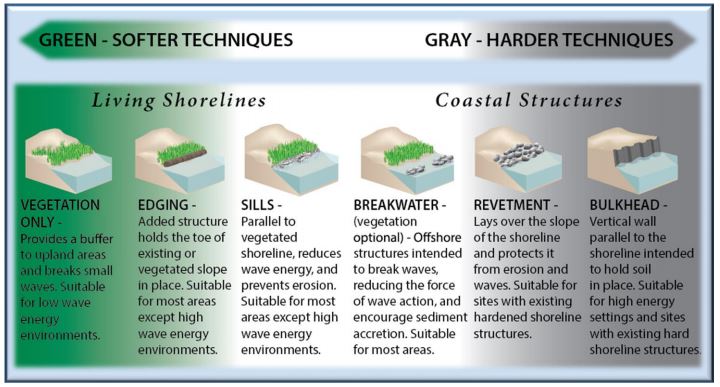Reprinted from the Tideland News
OCEAN — Living shorelines – the use of marsh grass, oyster shells and other natural materials to protect eroding estuarine shorelines and crucial habitat instead of bulkheads – just got a big boost along the N.C. coast.
Supporter Spotlight
The N.C Coastal Federation, based in this small community in western Carteret County, has received a $570,000 grant from the National Oceanic and Atmospheric Administration to create living shorelines on select public and private lands on the N.C. coast.

The organization has long pushed living shorelines as more beneficial to the environment than bulkheads. It has partnered with numerous organizations to build living shorelines all along the coast. The federation, for instance, joined with Hammocks Beach State Park to build living shorelines at the park’s headquarters near Swansboro and at Jones Island in the White Oaks River. It worked with Carteret Community College in Morehead City on a project along Bogue Sound, with N.C. Audubon to protect a bird rookery in Pamlico Sound and with the N.C. Center for the Advancement of Teaching to protect shoreline on Ocracoke.
The federation has also been involved in numerous smaller living shorelines projects as an advisor to individual property owners.
The grant is part of more than $4 million Coastal Ecosystem Resiliency Grants Program. NOAA’s National Marine Fisheries Service funds restoration projects that help ecosystems recover from extreme weather and changing environmental conditions and provide habitat to support sustainable fisheries and contribute to the recovery of protected species.
The federation plans to use the money to establish living shorelines that restore coastal marsh habitat, explained Lexia Weaver, a federation scientist.
Supporter Spotlight
“We have several sites picked out and we’re working with NOAA to create selection criteria for years two and three,” said Christine Miller, the federation’s assistant director responsible for government fundraising, including grant writing.

According to Weaver, the sites chosen include a 500-foot stretch of shoreline at Hammocks Beach to help protect the visitor’s center. Work is also planned at Sea Level in Down East Carteret County and at the Trinity Center in Pine Knoll Shores. Work is also planned at various locations along the coast, including Ocracoke Island, Morris Landing at Stump Sound in Onslow County and Carolina Beach State Park.
The federation noted in its grant application that the state’s 2.1 million acres of estuaries “is on the frontlines of … challenges” to protect the nation’s disappearing marshes and wetlands.
“Estuarine fringing marsh shorelines are being walled off and degraded by vertical bulkheads and other hard stabilization measures,” Miller wrote in the application. “Each year in North Carolina, many more bulkheads are constructed along estuarine shorelines than living shorelines. As of 2013, records show that 125 living shorelines, compared to 9,962 bulkheads (or more than 600 miles), have been installed.”
Recent research out of University of North Carolina at Chapel Hill’s Institute of Marine Sciences found that, after Hurricane Irene, bulkheads sustained significant damage while marshes and living shorelines did not, the application notes.
It’s believed, according to the application, that the living shoreline projects will provide crucial habitat for many marine species, including shrimp, oysters and red drum, the state fish.
There’s already strong and growing evidence that living shorelines work. For example, back in 2007, Hammocks Beach State Park was experiencing a big problem: The shoreline of Jones Island in the mouth of White Oak River was eroding fast. The park and the federation hit upon an idea that at the time was unusual: They’d try to stop or slow the process not with rocks or a seawall, but with a natural system now known as a “living shoreline,” which in this case consisted of marsh grass plantings and oyster reefs built with recycled shells.

More than 70,000 salt marsh grass plugs have been planted and 16,000 bushels of shells have created 11 new oyster reefs.
Park Ranger Jake Vitak said the difference in the erosion rate has been noticeable. “There’s still going to be some, because of the wind, but it’s much slower now,” he said. “The water is calmed down because of the oyster reefs we put in, and that has allowed that Spartina grass to really take off and fill in.”
And that’s just what a report released earlier this year concluded. Living Shorelines: From Barriers to Opportunities by Restore America’s Estuaries, a national nonprofit umbrella organization of conservation groups, concludes that, “Living shorelines are the best shoreline management alternative for both the environment and property owners when they are used in the right locations, designed correctly, constructed properly, and maintained appropriately.”
Federation founder and executive director Todd Miller, who chaired the committee that produced the report, said the positive conclusion was by no means a given when the panel started its work. And he insisted it was neither casually reached nor intended to imply that bulkheads and the other “hard” structures that line estuarine rivers and sounds have no place or role to play.
Rather, he said, the committee conducted an extensive review of existing research before the members were convinced that living shorelines merited such a solid boost not just for the environmental benefits they provide, but also for the property protection they offer.
Miller said he thinks the report makes a solid case for both conservationists and landowners and lays out a road map to increase use of shoreline protection techniques that are becoming more accepted but still face resistance from some government officials who are more comfortable with the old methods – chiefly bulkheads – and from property owners who in some cases might never have seen natural protection measures or ever considered using them.
“There has been a gradual increase in acceptance and use of living shorelines, but there are still plenty of impediments, especially in terms of ease of permitting,” he said.
This story is provided courtesy of the Tideland News, a weekly newspaper in Swansboro. Coastal Review Online is partnering with the Tideland to provide readers with more environmental and lifestyle stories of interest about our coast. You can read other stories about the Swansboro area here.







